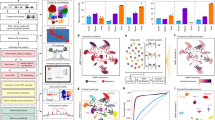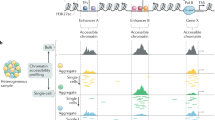Abstract
CRISPR screens have been used to connect genetic perturbations with changes in gene expression and phenotypes. Here we describe a CRISPR-based, single-cell combinatorial indexing assay for transposase-accessible chromatin (CRISPR–sciATAC) to link genetic perturbations to genome-wide chromatin accessibility in a large number of cells. In human myelogenous leukemia cells, we apply CRISPR–sciATAC to target 105 chromatin-related genes, generating chromatin accessibility data for ~30,000 single cells. We correlate the loss of specific chromatin remodelers with changes in accessibility globally and at the binding sites of individual transcription factors (TFs). For example, we show that loss of the H3K27 methyltransferase EZH2 increases accessibility at heterochromatic regions involved in embryonic development and triggers expression of genes in the HOXA and HOXD clusters. At a subset of regulatory sites, we also analyze changes in nucleosome spacing following the loss of chromatin remodelers. CRISPR–sciATAC is a high-throughput, single-cell method for studying the effect of genetic perturbations on chromatin in normal and disease states.
This is a preview of subscription content, access via your institution
Access options
Access Nature and 54 other Nature Portfolio journals
Get Nature+, our best-value online-access subscription
$29.99 / 30 days
cancel any time
Subscribe to this journal
Receive 12 print issues and online access
$209.00 per year
only $17.42 per issue
Buy this article
- Purchase on Springer Link
- Instant access to full article PDF
Prices may be subject to local taxes which are calculated during checkout




Similar content being viewed by others
Data availability
Processed and raw data can be downloaded from NCBI GEO (PRJNA674902, GSE161002).
Code availability
The scripts and pipeline for the analysis can be found at https://gitlab.com/sanjanalab/crispr-sciatac.
References
Flavahan, W. A., Gaskell, E. & Bernstein, B. E. Epigenetic plasticity and the hallmarks of cancer. Science 357, eaal2380 (2017).
Datlinger, P. et al. Pooled CRISPR screening with single-cell transcriptome readout. Nat. Methods 14, 297–301 (2017).
Adamson, B. et al. A multiplexed single-cell CRISPR screening platform enables systematic dissection of the unfolded protein response. Cell 167, 1867–1882 (2016).
Dixit, A. et al. Perturb-seq: dissecting molecular circuits with scalable single-cell RNA profiling of pooled genetic screens. Cell 167, 1853–1866 (2016).
Jaitin, D. A. et al. Dissecting immune circuits by linking CRISPR-pooled screens with single-cell RNA-seq. Cell 167, 1883–1896 (2016).
Rubin, A. J. et al. Coupled single-cell CRISPR screening and epigenomic profiling reveals causal gene regulatory networks. Cell 176, 361–376 (2019).
Cusanovich, D. A. et al. Multiplex single-cell profiling of chromatin accessibility by combinatorial cellular indexing. Science 348, 910–914 (2015).
Forbes, S. A. et al. COSMIC: somatic cancer genetics at high-resolution. Nucleic Acids Res. 45, D777–D783 (2017).
Kolde, R., Laur, S., Adler, P. & Vilo, J. Robust rank aggregation for gene list integration and meta-analysis. Bioinformatics 28, 573–580 (2012).
Wang, T. et al. Identification and characterization of essential genes in the human genome. Science 350, 1096–1101 (2015).
Margueron, R. & Reinberg, D. The Polycomb complex PRC2 and its mark in life. Nature 469, 343–349 (2011).
Margueron, R. et al. Ezh1 and Ezh2 maintain repressive chromatin through different mechanisms. Mol. Cell 32, 503–518 (2008).
Mathelier, A. et al. JASPAR 2016: a major expansion and update of the open-access database of transcription factor binding profiles. Nucleic Acids Res. 44, D110–D115 (2016).
Schep, A. N., Wu, B., Buenrostro, J. D. & Greenleaf, W. J. ChromVAR: inferring transcription-factor-associated accessibility from single-cell epigenomic data. Nat. Methods 14, 975–978 (2017).
Medvedeva, Y. A. et al. EpiFactors: a comprehensive database of human epigenetic factors and complexes. Database (Oxford) 2015, bav067 (2015).
Lejeune, E. et al. The chromatin-remodeling factor FACT contributes to centromeric heterochromatin independently of RNAi. Curr. Biol. 17, 1219–1224 (2007).
Mathur, R. et al. ARID1A loss impairs enhancer-mediated gene regulation and drives colon cancer in mice. Nat. Genet. 49, 296–302 (2017).
Nord, A. S. et al. Rapid and pervasive changes in genome-wide enhancer usage during mammalian development. Cell 155, 1521–1531 (2013).
Vierbuchen, T. et al. AP-1 transcription factors and the BAF complex mediate signal-dependent enhancer selection. Mol. Cell 68, 1067–1082 (2017).
Hakimi, M. A. et al. A chromatin remodelling complex that loads cohesin onto human chromosomes. Nature 123, 3175–3184 (2002).
Wen, Z., Huang, Z. T., Zhang, R. & Peng, C. ZNF143 is a regulator of chromatin loop. Cell Biol. Toxicol. 34, 471–478 (2018).
Swiers, G., Patient, R. & Loose, M. Genetic regulatory networks programming hematopoietic stem cells and erythroid lineage specification. Dev. Biol. 294, 525–540 (2006).
Li, M. et al. Dynamic regulation of transcription factors by nucleosome remodeling. Elife 4, e06249 (2015).
Kundaje, A. et al. Ubiquitous heterogeneity and asymmetry of the chromatin environment at regulatory elements. Genome Res. 22, 1735–1747 (2012).
Kelso, T. W. R. et al. Chromatin accessibility underlies synthetic lethality of SWI/SNF subunits in ARID1A-mutant cancers. Elife 6, e30506 (2017).
Guo, X., Chitale, P. & Sanjana, N. E. Target discovery for precision medicine using high-throughput genome engineering. Adv. Exp. Med. Biol. 1016, 123–145 (2017).
Papalexi, E. et al. Characterizing the molecular regulation of inhibitory immune checkpoints with multimodal single-cell screens. Nat. Genet. 53, 322–331 (2021).
Shalem, O. et al. Genome-scale CRISPR-Cas9 knockout screening in human cells. Science 343, 84–87 (2014).
Shi, J. et al. Discovery of cancer drug targets by CRISPR-Cas9 screening of protein domains. Nat. Biotechnol. 33, 661–667 (2015).
Meier, J. A., Zhang, F. & Sanjana, N. E. GUIDES: sgRNA design for loss-of-function screens. Nat. Methods 14, 831–832 (2017).
Picelli, S. et al. Tn5 transposase and tagmentation procedures for massively scaled sequencing projects. Genome Res. 24, 2033–2040 (2014).
Thompson, J. D., Higgins, D. G. & Gibson, T. J. CLUSTAL W: improving the sensitivity of progressive multiple sequence alignment through sequence weighting, position-specific gap penalties and weight matrix choice. Nucleic Acids Res. 22, 4673–4680 (1994).
Goryshin, I. Y. & Reznikoff, W. S. Tn5 in vitro transposition. J. Biol. Chem. 273, 7367–7374 (1998).
Nørholm, M. A mutant Pfu DNA polymerase designed for advanced uracil-excision DNA engineering. BMC Biotechnol. 10, 21 (2010).
Buenrostro, J. D., Giresi, P. G., Zaba, L. C., Chang, H. Y. & Greenleaf, W. J. Transposition of native chromatin for fast and sensitive epigenomic profiling of open chromatin, DNA-binding proteins and nucleosome position. Nat. Methods 10, 1213–1218 (2013).
Richter, K. N. et al. Glyoxal as an alternative fixative to formaldehyde in immunostaining and super‐resolution microscopy. EMBO J. 37, 139–159 (2017).
Adey, A. et al. In vitro, long-range sequence information for de novo genome assembly via transposase contiguity. Genome Res. 24, 2041–2049 (2014).
Amini, S. et al. Haplotype-resolved whole-genome sequencing by contiguity-preserving transposition and combinatorial indexing. Nat. Genet. 46, 1343–1349 (2014).
Liu, X. S. et al. MAGeCK enables robust identification of essential genes from genome-scale CRISPR/Cas9 knockout screens. Genome Biol. 15, 554 (2014).
Preissl, S. et al. Single-nucleus analysis of accessible chromatin in developing mouse forebrain reveals cell-type-specific transcriptional regulation. Nat. Neurosci. 21, 432–439 (2018).
Langmead, B., Trapnell, C., Pop, M. & Salzberg, S. L. Ultrafast and memory-efficient alignment of short DNA sequences to the human genome. Genome Biol. 10, R25 (2009).
Langmead, B. & Salzberg, S. L. Fast gapped-read alignment with Bowtie 2. Nat. Methods 9, 357–359 (2012).
Eden, E., Navon, R., Steinfeld, I., Lipson, D. & Yakhini, Z. GOrilla: a tool for discovery and visualization of enriched GO terms in ranked gene lists. BMC Bioinformatics 10, 48 (2009).
Võsa, U. et al. Unraveling the polygenic architecture of complex traits using blood eQTL meta-analysis. Preprint at bioRxiv https://doi.org/10.1101/447367 (2018).
The GTEx Consortium. The GTEx Consortium atlas of genetic regulatory effects across human tissues. Science 369, 1318–1330 (2020).
Quinlan, A. R. & Hall, I. M. BEDTools: a flexible suite of utilities for comparing genomic features. Bioinformatics 26, 841–842 (2010).
Duttke, S. et al. Identification and dynamic quantification of regulatory elements using total RNA. Genome Res. 29, 1836–1846 (2019).
Benjamini, Y. & Hochberg, Y. Controlling the false discovery rate: a practical and powerful approach to multiple testing. J. R. Stat. Soc. Ser. B Stat. Methodol. 57, 289–300 (1995).
Acknowledgements
We thank the entire Sanjana laboratory for support and advice. We thank J. Morris for help with eQTL resources, M. Zaran and R. Satija for computational resources and the NYGC Sequencing Platform and NYU Biology Genomics Core for sequencing resources. BL21(DE3) cells transformed with pET-PfuX7 were kindly provided by J. Gregory. N.L.-B. is supported by a postdoctoral fellowship from the Human Frontier Science Program Organization (no. LT000672/2019-L), an EMBO long-term fellowship (no. ALTF 826-2018) and the Weizmann Institute of Science National Postdoctoral Award Program for Advancing Women in Science. N.E.S. is supported by NYU and NYGC startup funds, NIH/NHGRI (nos. R00HG008171 and DP2HG010099), NIH/NCI (no. R01CA218668), DARPA (no. D18AP00053), the Sidney Kimmel Foundation, the Melanoma Research Alliance and the Brain and Behavior Foundation.
Author information
Authors and Affiliations
Contributions
N.E.S. conceived and supervised the project. N.E.S., A.M. and N.L.-B. designed the experiments. A.M., N.L.-B., J.D., A.M.-M., C.-Y.K. and A.S. performed the experiments. N.L.-B., A.M., J.D., N.E.S., H.-H.W. and N.G.M. analyzed the data. P.S. isolated TnY. S.J. purified PhuX7. A.M., J.D., C.-Y.K., A.S., P.S. and S.J. purified TnY. N.L.-B., A.M. and N.E.S. wrote the manuscript with input from all authors.
Corresponding author
Ethics declarations
Competing interests
The New York Genome Center and New York University have applied for patents relating to the work in this article. N.E.S. is an adviser to Vertex.
Additional information
Publisher’s note Springer Nature remains neutral with regard to jurisdictional claims in published maps and institutional affiliations.
Supplementary information
Supplementary Information
Supplementary Figs. 1–14 and Sequences.
Supplementary Table 1
Number of cells in each step of the CRISPR–sciATAC protocol.
Supplementary Table 2
Sequences of oligonucleotides for CRISPR–sciATAC, CRISPR libraries and RT–qPCR.
Supplementary Table 3
Gene and gRNA enrichment from essentiality screen.
Supplementary Table 4
ENCODE ChIP data sources.
Supplementary Table 5
Histone mark differential accessibility.
Supplementary Table 6
GO enrichment results for differential accessibility in EZH2-targeted cells.
Supplementary Table 7
Transcription factor binding site differential accessibility.
Supplementary Table 8
Cost comparison between CRISPR–sciATAC and Perturb–ATAC protocols.
Supplementary Table 9
Time comparison between CRISPR–sciATAC and Perturb–ATAC protocols.
Rights and permissions
About this article
Cite this article
Liscovitch-Brauer, N., Montalbano, A., Deng, J. et al. Profiling the genetic determinants of chromatin accessibility with scalable single-cell CRISPR screens. Nat Biotechnol 39, 1270–1277 (2021). https://doi.org/10.1038/s41587-021-00902-x
Received:
Revised:
Accepted:
Published:
Issue Date:
DOI: https://doi.org/10.1038/s41587-021-00902-x
This article is cited by
-
txci-ATAC-seq: a massive-scale single-cell technique to profile chromatin accessibility
Genome Biology (2024)
-
Inhibition of demethylase by IOX1 modulates chromatin accessibility to enhance NSCLC radiation sensitivity through attenuated PIF1
Cell Death & Disease (2023)
-
High-content CRISPR screening
Nature Reviews Methods Primers (2022)
-
Generating specificity in genome regulation through transcription factor sensitivity to chromatin
Nature Reviews Genetics (2022)



